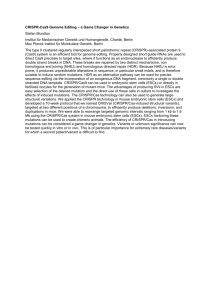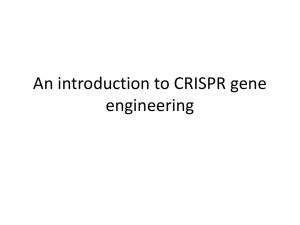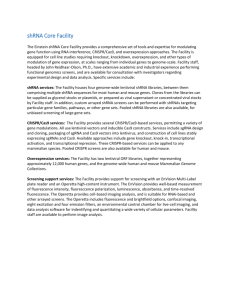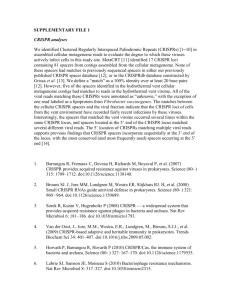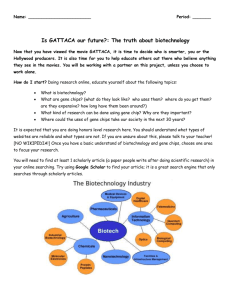application of crispr–enabled gene drive approach to eradicating
advertisement
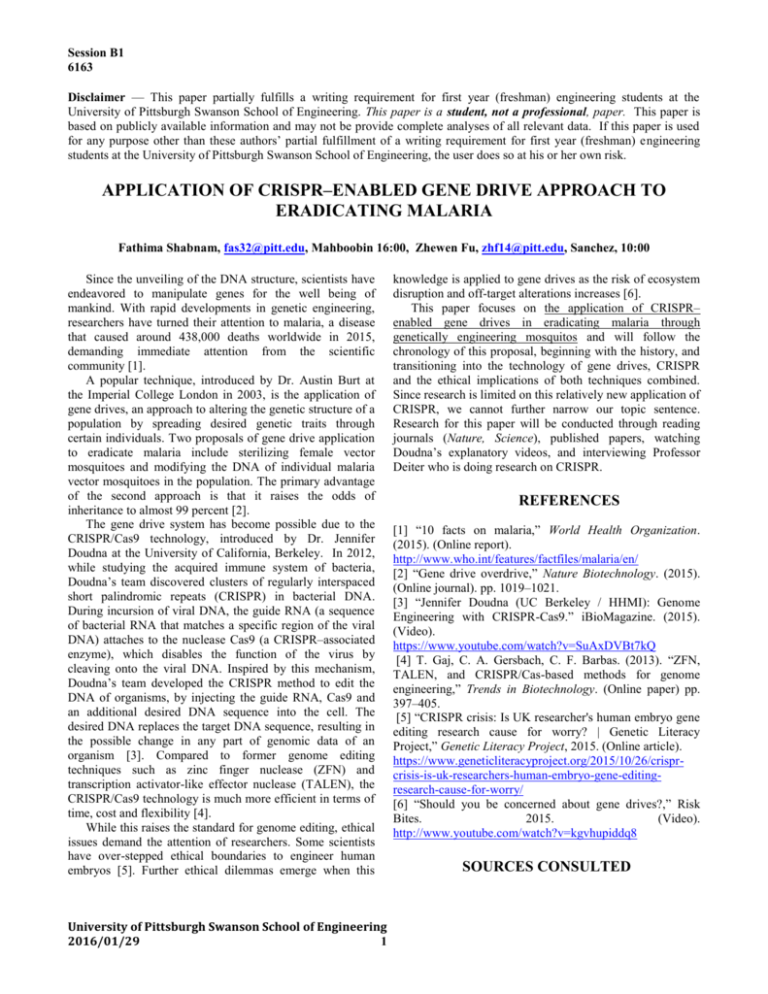
Session B1 6163 Disclaimer — This paper partially fulfills a writing requirement for first year (freshman) engineering students at the University of Pittsburgh Swanson School of Engineering. This paper is a student, not a professional, paper. This paper is based on publicly available information and may not be provide complete analyses of all relevant data. If this paper is used for any purpose other than these authors’ partial fulfillment of a writing requirement for first year (freshman) engineering students at the University of Pittsburgh Swanson School of Engineering, the user does so at his or her own risk. APPLICATION OF CRISPR–ENABLED GENE DRIVE APPROACH TO ERADICATING MALARIA Fathima Shabnam, fas32@pitt.edu, Mahboobin 16:00, Zhewen Fu, zhf14@pitt.edu, Sanchez, 10:00 Since the unveiling of the DNA structure, scientists have endeavored to manipulate genes for the well being of mankind. With rapid developments in genetic engineering, researchers have turned their attention to malaria, a disease that caused around 438,000 deaths worldwide in 2015, demanding immediate attention from the scientific community [1]. A popular technique, introduced by Dr. Austin Burt at the Imperial College London in 2003, is the application of gene drives, an approach to altering the genetic structure of a population by spreading desired genetic traits through certain individuals. Two proposals of gene drive application to eradicate malaria include sterilizing female vector mosquitoes and modifying the DNA of individual malaria vector mosquitoes in the population. The primary advantage of the second approach is that it raises the odds of inheritance to almost 99 percent [2]. The gene drive system has become possible due to the CRISPR/Cas9 technology, introduced by Dr. Jennifer Doudna at the University of California, Berkeley. In 2012, while studying the acquired immune system of bacteria, Doudna’s team discovered clusters of regularly interspaced short palindromic repeats (CRISPR) in bacterial DNA. During incursion of viral DNA, the guide RNA (a sequence of bacterial RNA that matches a specific region of the viral DNA) attaches to the nuclease Cas9 (a CRISPR–associated enzyme), which disables the function of the virus by cleaving onto the viral DNA. Inspired by this mechanism, Doudna’s team developed the CRISPR method to edit the DNA of organisms, by injecting the guide RNA, Cas9 and an additional desired DNA sequence into the cell. The desired DNA replaces the target DNA sequence, resulting in the possible change in any part of genomic data of an organism [3]. Compared to former genome editing techniques such as zinc finger nuclease (ZFN) and transcription activator-like effector nuclease (TALEN), the CRISPR/Cas9 technology is much more efficient in terms of time, cost and flexibility [4]. While this raises the standard for genome editing, ethical issues demand the attention of researchers. Some scientists have over-stepped ethical boundaries to engineer human embryos [5]. Further ethical dilemmas emerge when this University of Pittsburgh Swanson School of Engineering 2016/01/29 1 knowledge is applied to gene drives as the risk of ecosystem disruption and off-target alterations increases [6]. This paper focuses on the application of CRISPR– enabled gene drives in eradicating malaria through genetically engineering mosquitos and will follow the chronology of this proposal, beginning with the history, and transitioning into the technology of gene drives, CRISPR and the ethical implications of both techniques combined. Since research is limited on this relatively new application of CRISPR, we cannot further narrow our topic sentence. Research for this paper will be conducted through reading journals (Nature, Science), published papers, watching Doudna’s explanatory videos, and interviewing Professor Deiter who is doing research on CRISPR. REFERENCES [1] “10 facts on malaria,” World Health Organization. (2015). (Online report). http://www.who.int/features/factfiles/malaria/en/ [2] “Gene drive overdrive,” Nature Biotechnology. (2015). (Online journal). pp. 1019–1021. [3] “Jennifer Doudna (UC Berkeley / HHMI): Genome Engineering with CRISPR-Cas9.” iBioMagazine. (2015). (Video). https://www.youtube.com/watch?v=SuAxDVBt7kQ [4] T. Gaj, C. A. Gersbach, C. F. Barbas. (2013). “ZFN, TALEN, and CRISPR/Cas-based methods for genome engineering,” Trends in Biotechnology. (Online paper) pp. 397–405. [5] “CRISPR crisis: Is UK researcher's human embryo gene editing research cause for worry? | Genetic Literacy Project,” Genetic Literacy Project, 2015. (Online article). https://www.geneticliteracyproject.org/2015/10/26/crisprcrisis-is-uk-researchers-human-embryo-gene-editingresearch-cause-for-worry/ [6] “Should you be concerned about gene drives?,” Risk Bites. 2015. (Video). http://www.youtube.com/watch?v=kgvhupiddq8 SOURCES CONSULTED Fathima Shabnam Zhewen Fu A. Hammond, R. Galizi, K. Kyrou, et al. (2015). “A CRISPR-Cas9 gene drive system targeting female reproduction in the malaria mosquito vector Anopheles gambiae,” Nature Biotechnology. (Online paper) pp. 78–83. “CRISPR gene-drive mosquitoes could eradicate malaria | Front Line Genomics,” Front Line Genomics. http://www.frontlinegenomics.com/2836/crispr-gene-drivemosquitoes-could-eradicate-malaria/ “Video for instructions on use of Library”. Swanson School of Engineering. (Video). http://www.library.pitt.edu/other/files/il/fresheng/index.html “Jennifer Doudna (UC Berkeley / HHMI): Genome Engineering with CRISPR-Cas9.” (2015). iBioMagazine. (video). https://www.youtube.com/watch?v=SuAxDVBt7kQ This is an explanatory video on YouTube posted by iBioMagazine in which Dr. Jennifer Doudna, the researcher who came up with the idea of the CRISPR/Cas9 system, explains the technology in detail. The information from this will aid us to give a detailed explanation of the CRISPR/Cas9 technology and inform the readers about the importance of it. ANNOTATED BIBLIOGRAPHY K. M. Esvelt, A. L. Smidler, F. Catteruccia, and G. M. Church. (2014). “Concerning RNA-guided gene drives for the alteration of wild populations.” eLife. DOI: 10.1101/007203 vol. 3 This peer-reviewed article in eLife, an online scientific journal, engages in a comprehensive introduction of the application of CRISPR-Cas9 in promoting genetic modifications among wild populations. In a systematic approach, the article also serves to generate discussions around the implications of CRISPR-enabled gene drives, while offering potential failsafe solutions to the consequences. This information serves as a foundation to the ethics section of our paper as we will discuss the drawbacks of this technology. A. Hammond, R. Galizi, K. Kyrou, et al. (2015). “A CRISPR-Cas9 gene drive system targeting female reproduction in the malaria mosquito vector Anopheles gambiae.” Nature Biotechnology. (online article). DOI: 10.1038/nbt.3439 Vol. 34, no. 1, pp. 78–83. This research paper, published in Nature Biotechnology, introduces the gene drive approach to eradicate malaria, using CRISPR-Cas9 by targeting reproduction of female vector mosquitos. Of the two techniques of gene drives, this idea of sterilizing female mosquitoes to reduce the spread of disease raises a plethora of ethical discussions. Since our paper discusses the gene drive approach to eradicate malaria, this research article serves as a crucial tool for understanding this application of CRISPR. T. Gaj, C. A. Gersbach and C. F. Barbas. (2013). “ZFN, TALEN, and CRISPR/Cas-based methods for genome engineering,” Trends in Biotechnology. (online article). DOI: 10.1016/j.tibtech.2013.04.004 Pp. 397–405. This peer-reviewed paper published in Trends in Biotechnology, provides information and limitations of preexisting genome editing tools such as ZFN and TALEN and highlights crucial differences between them and the CRISPR tool. This is useful, as we will discuss the purpose, significance, and the reason why CRISPR has revolutionized genome editing along with what improvements have to be made with the CRISPR technology. E. Pennisi. (2015). “Gene drive workshop shows technology’s promise, or peril, remains far off.” Science. (online article) http://www.sciencemag.org/news/2015/10/gene-driveworkshop-shows-technology-s-promise-or-peril-remains-far This news article published in the journal Science focuses on the drawbacks of using a gene drive to eradicate malaria. The points discussed in the article are from National Academies of Sciences, Engineering, and Medicine (NAS) workshop in Washington. This information will be used to outline the primary prospective of CRISPR technology, including its advantages and its disastrous consequences. V. M. Gantz, N. Jasinskiene, O. Tatarenkova, et al. (2015). “Highly efficient Cas9-mediated gene drive for population modification of the malaria vector mosquito Anopheles stephensi.” Proceedings of the National Academy of Sciences of the United States of America. (online article). DOI: 10.1073/pnas.1521077112 Vol. 112, no. 49. This is a peer-reviewed article in the scientific journal, PNAS. This article focuses on the more advisable approach to using CRISPR-Cas9 gene drives to extinguish mosquitoes’ abilities to carry plasmodium falcipurum, which is the most common malaria parasite rather than annihilating the entire malaria vector species. Since this is the second techniques of gene drives, it serves as an important tool for understanding the application and implications of this approach. H. Ledford . (2014). “CRISPR, the disruptor.” Nature. (online article) http://www.nature.com/news/crispr-the-disruptor-1.17673 This news-featured article, published in Nature, emphasizes on the concerning ethical issues. With its ability to engineer entire ecosystems, CRISPR-enabled gene drive arouses consternation among researchers as to whether it is an indispensable tool to improve life or whether it is an unethical disruption to nature. This is going to be used for a general overview of the technology and also for the possibilities it holds. 2 Fathima Shabnam Zhewen Fu Y. Fu, J. A. Foden, C. Khayter, et al. (2013). “Highfrequency off-target mutagenesis induced by CRISPR-Cas nucleases in human cells.” Nature Biotechnology. (online article). DOI: 10.1038/nbt.2623 Vol. 31, no. 9, pp. 822–826. This peer-reviewed paper, published in Nature, discusses the chances of off-target mutations from the CRISPR-Cas9 system. It was found that CRISPR RNA-guided endonucleases are active even with imperfectly matched RNA-DNA interfaces in human cells, producing unreliable data in research and therapeutic applications. This information will be used in this paper to discuss the reliability of the CRISPR technology. 3

